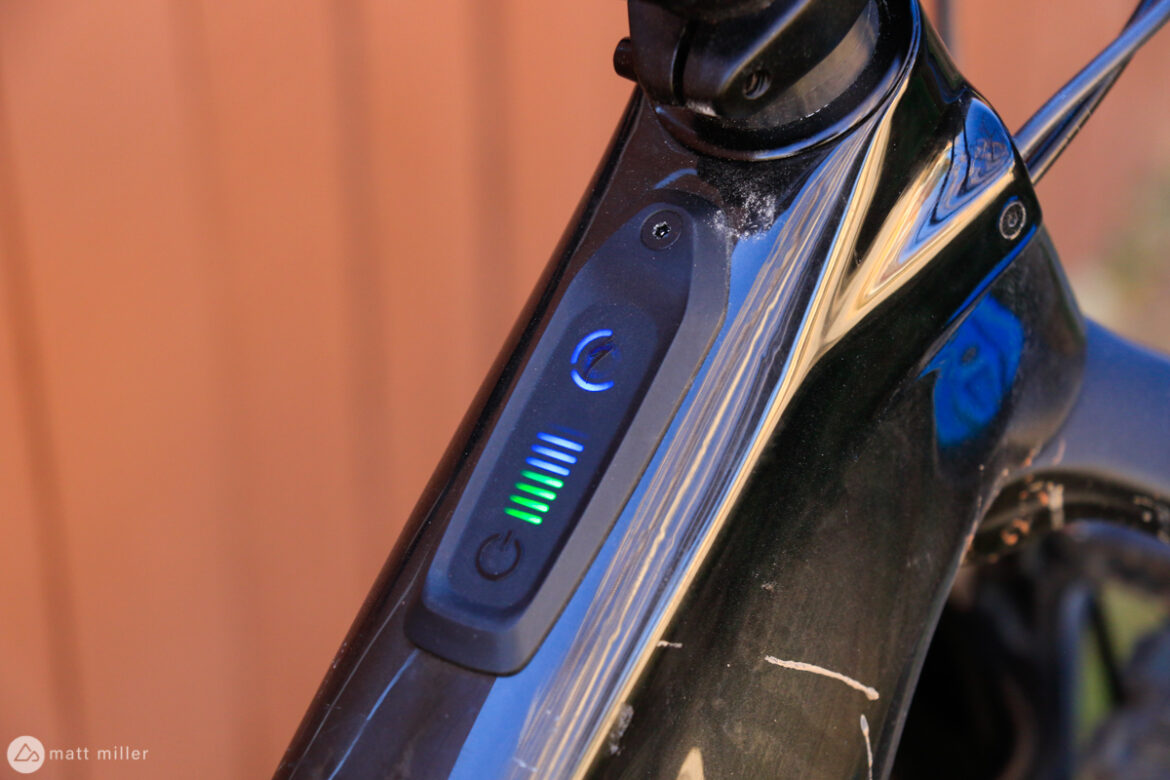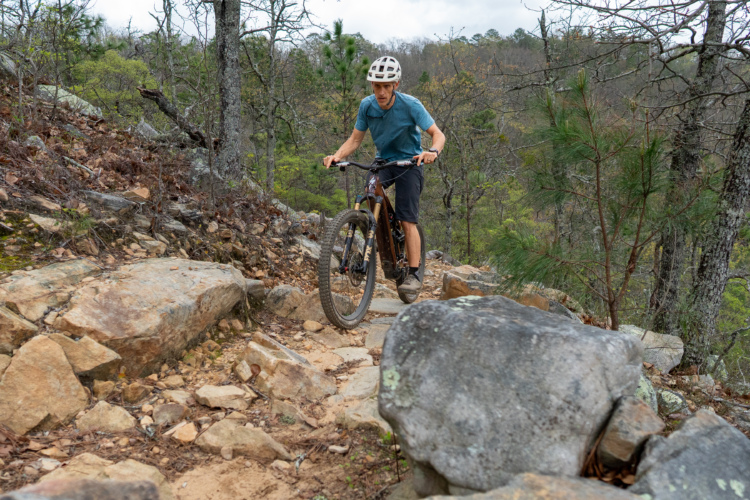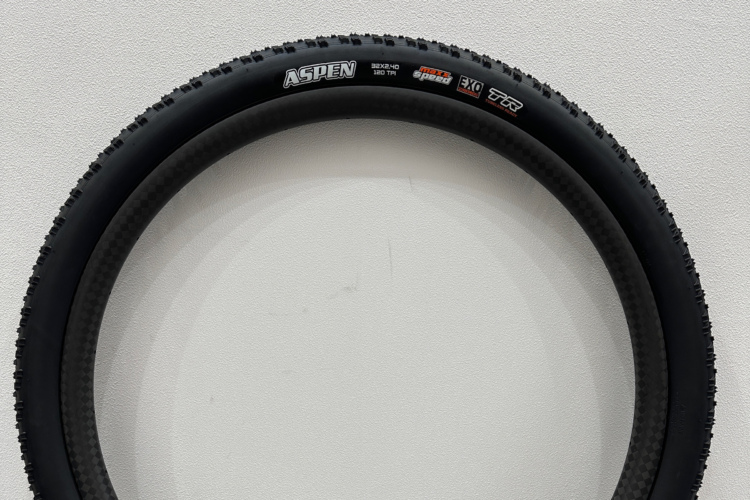
Toward the end of October when I am usually wrapping up bike reviews for the incoming winter weather in Colorado, I had the opportunity to squeeze in one more with the Specialized Turbo Levo SL. After covering eMTB access issues for more than two years now, I hadn’t actually spent any time riding e-bikes on singletrack. My context was lacking, and it only made sense to really get to know e-bikes on a more personal level.
A Light-Duty E-MTB
The new Specialized Turbo Levo SL electric mountain bike seemed like the perfect bike to try. To some, an e-bike is an e-bike. To others, an e-bike is a motorcycle. But, for those who can allow themselves to understand the machines more, will find that the SL is a light-duty eMTB.
The battery and motor have been scaled down and the geometry is conservative. Electric mountain bikes have often been heavy, cumbersome, and long, and the Turbo Levo SL has been designed for a new take.

Specialized Turbo Levo Electric Bike Motor
To give a little bit more context on why the Specialized Turbo Levo SL is different from the standard Specialized Turbo Levo, we have to look at the motors. The Turbo Levo SL has a Specialized SL 1:1 240W motor with a 230Wh battery, compared to the Turbo Levo’s 565W motor and 700Wh battery.
The torque rating on the SL is 35Nm, compared to the TL’s 90Nm. By using a much smaller motor and battery, this Specialized electric mountain bike is almost 10lbs lighter than the Turbo Levo.
Specialized Turbo Levo vs. Turbo Kenevo
The Specialized Turbo Levo and the Turbo Kenevo both have more travel, and eMTBs as a whole seem well-suited to longer travel categories. What’s the worst part about long-travel or downhill bikes? Their climbing capability. Stuff a motor and battery underneath it and suddenly it makes sense to have a 180mm-travel bike around that someone will consider climbing to the top of the trail on.
The Specialized Turbo Levo SL approaches the situation differently and is an eMTB made for everyday trail riding.

Specialzed Turbo Levo SL Specs
At the front and rear, there is six-inches of travel and 29-inch wheels. Touches like an inline Fox DPS shock, Fox 34 fork, and SRAM G2 brakes are all signs that this isn’t the battering ram of an eMTB that the new Santa Cruz Bullit or the Specialized Turbo Kenevo are, though some of the 2021 SL models do come with a Fox 36.
The 2020 Expert Carbon build I have been testing ($9,025 MSRP) features a set of Roval Traverse carbon wheels, a SRAM GX 12-speed drivetrain, an X-Fusion Manic 125mm dropper post, an alloy Specialized cockpit, and a Specialized Butcher/Eliminator tire combo.
Range Extender
On my scale, without pedals and with the Range Extender – a $450 water bottle-sized battery that fits in the frame and adds 160Wh of life – the Specialized Turbo Levo SL Expert Carbon weighs 41lbs.
The Range Extender says it’s capable of adding “up to 40 additional miles,” on top of the “up to 80 miles,” of the SL’s main battery. The range as a whole is determined by a lot of different variables from the direction the wind is blowing that day, to the rider’s weight, how they use their gearing, what power mode they use, the terrain, and so on.
There are three different modes on the Turbo Levo SL — Eco mode, Trail mode, and Turbo mode — which are controlled by a handlebar remote next to the dropper lever.

Specialized Turbo Levo Ride impressions
As summer wound down, I wasn’t hauling my bike up to the high country for all-day rides. I still had time to ride on the weekends and found my ideal application for the eMTB: leaving my car at home and pedaling to the trails.
I live about five miles away from some of my closest trails, so it’s a quick drive but ten miles of commuting by bike to a trail is a long ride on top of the planned singletrack. The Specialized electric mountain bike makes pedaling a knobby-tired 150mm travel bike down the paved path much more bearable.
The Specialized SL 1:1 motor kicks in smoothly, without any jerking or unwanted motion or torque. In Eco mode, I’d say it feels like it takes about 25% of the effort away, but I found out quickly that just because there’s some electric assistance underneath, it doesn’t make everything easier.
Even though the SL motor easily adapts to the input the rider is giving, going into technical climbs with more power and speed takes some getting used to. In other words, quicker climbing requires quicker handling.

I never felt that I had too much torque though, and clearing rocky climbs is still dependent on the rider’s skill and the gearing that they are in; the SL motor always felt like it was working directly off of what I put into the crankset. Riders can further customize their motor and power output with the Specialized Mission Control app. Peak power, support, and acceleration response can be tuned to extend the range and micro-adjust how the bike feels under power.
I took the Specialized electric bike for some three- to four-hour-long rides at a time, with about 25-30 miles and a few thousand feet of elevation gain, and usually ended with a third or even half of the battery left.

Specialized Turbo Levo Geo
The geometry is conservative, given that the SL is a 150mm travel 29er, but that works in favor of the eMTB. The 75° STA isn’t as steep as other mountain bikes in this travel range, but with the motor I didn’t feel as strained on the climbs as I would with a non-motorized bike with a slacker seat tube angle. The shorter 1,185mm wheelbase and snappy 66° head tube angle gives the SL an agile personality with responsive handling.
For the most part, the Specialized Turbo Levo SL still feels like a planted and speed-hungry mountain bike. The SL is light for an eMTB, but at 42lbs. on the trail, is hefty still and made me work a little to get it airborne or to throw it around. I’d liken it to the personality that many enduro bikes have; focused on a straight line, but willing to play.
Where the SL’s build kit seemed to be at odds, was near the front end. I can see why Specialized would have initially specced the Turbo Levo SL with a Fox 34 to save weight and differentiate the bike from it’s heavier-hitting counterparts, but a 36, though heavier, would make this e-bike an even more responsive bike and inspire more confidence on the descents, when the heavy bike is taking repetitive head-on hits.

For 2021, Specialized has specced the S-Works and Expert Turbo Levo models with a Fox 36 and DPX2 shock, and SRAM Code brakes rather than G2s, upping the price a few hundred dollars.
I would assume that the low-slung weight on the Specialized Turbo Levo SL helped the bike with its ability to rail corners. It’s a blast around sweeping corners and feels glued to the ground, while the short rear center makes it easy to whip around tighter switchbacks.
The 125mm dropper post was noticeably short though and I could feel the saddle hitting me on steeper trails. It also looks like Specialized has updated the latest size medium bikes to come with a 150mm post.

Specialized Turbo Levo SL background and specs
Specialized came out with their Turbo Levo SL earlier this year and for lack of a better word, it was…revolutionary. I’m not a big fan of that word, because most brands claim that their bikes are revolutionary in every new release, and that’s rarely the case. But, the Turbo Levo SL is much lighter than both the Turbo Levo and Turbo Kenovo — and most other eMTBs — thanks to a smaller, lighter motor which gives the bike a much leaner stance and silhouette than its siblings — and the competition.
Electric mountain bikes have had a reputation as being chunky, awkward, and heavy since their inception. That’s left the field with e-bikes that are A) ugly, and B) heavy. So, not only do people not want to be seen riding a bike that looks pregnant with another bike, they aren’t known for being all that fun to descend on either, when many are tipping the scales at nearly 50lbs.
The Turbo Levo SL whittles weight down to 38lbs. on the lightest build kit with a smaller motor and less battery than both the Turbo Levo and Kenevo for an eMTB that is not as eMTB as other eMTBs. The 29er has 150mm of travel front and rear.

The SL has a 240W motor with a stock 320Wh lithium-ion battery inserted in the downtube that generates 35Nm of torque. Specialized also introduced the Range Extender, a water-bottle-sized battery that fits in a water bottle cage. The feeling you get with the lighter motor and wattage output is an e-bike that wants a little more power from the rider.
For reference, the Turbo Levo has a 565W motor with 700Wh of battery power and a torque rating of 90Nm. It seems like Specialized is pointing the industry in a new direction with the Turbo Levo SL, and Orbea’s new lightweight Rise seems to follow the trend.


It’s hard to get a square estimate for battery range as that can vary in many ways. Range depends on terrain, rider weight, elevation gain, gearing, power mode, and so on. With the range extender, I’ve found battery life to be decent. So far, I’ve put about 40 miles and 5,000 feet of elevation on the bike and I am about halfway through the total battery life. I have primarily been using Eco mode, with some Trail mode here and there. Riders can also tune the output via the Specialized Mission Control app.
Geometry is much more akin to a normal mountain bike. With the smaller powertrain, Specialized has trimmed the angles down quite a bit. On the medium, the reach is shorter than average at 435mm, as is the wheelbase at 1185mm. Standover height is 790mm. With the short seat tube length of 410mm, it feels like the SL sits a bit higher. That’s probably because the bottom bracket height is 348mm. The chain stays are 437mm long while the HTA and STA are 66° and 75°, respectively.

This Expert build has a decent spec. Suspension is controlled with a Fox Float DPS Performance shock and a Fox Performance 34 fork. The cockpit is specced with Specialized OEM components and an X-Fusion Manic dropper post. Stopping power is nice with SRAM G2 RSCs. This build comes with a SRAM GX Eagle drivetrain and Roval Traverse carbon wheels and DT Swiss 370 hubs. With the Range Extender, the SL Expert build weighs 41 lbs.
All this comes in at a price that is best described as “ouch” for a mountain bike and “not terrible” for an eMTB; the Turbo Levo SL Expert rings the register at $9,025. The 2021 model ups the price even more to $9,500.

Closing thoughts
As a whole, the Specialized Turbo Levo SL delivers a unique experience for eMTBs. With a lighter motor and battery, conservative geometry, and the right component spec, the e-bike is agile, light, and seamless.
For electric mountain bikes, brands seem to be making bikes in two camps: heavyweight, long-travel bikes with larger motors which equate to an easy-to-pedal downhill bike. Or, like the Specialized Turbo Levo SL and new Orbea Rise: a motor-assisted trail bike with lightweight components for riders who want a livelier ride feel. Specialized has done a great job steering the conversation toward the latter.
- Price: $7,000-$14,500
- Available at Specialized.
Show your Support
Become a Singletracks Pro Supporter today and enjoy benefits like ad-free browsing.
With your support we can provide free worldwide trail information and original content created by our team of independent journalists.





















13 Comments
Dec 25, 2020
There are still plenty of unfounded myths about Ebike performance out there, and I would encourage those who disparage them to give them a try and see what.exactly. they are all about, and why the pedal assist bikes are compatible with trail riding on a regular bike.
Happy holidays.
Jul 8, 2023
The bike is playful on the trails, and the weight is almost unnoticeable. I can now keep up with my (much) younger friends when riding uphill so they don't have to wait for me! I still ride my non-eBike for Solo and the "beginner" rides I lead, but this bike has proved to be a wonderful addition to my stable.
As others have said, we have an uphill battle here with the misconceptions and myths about what eBikes are and what they do, but they are definitely a plus for me.
Dec 24, 2020
Dec 21, 2020
Dec 25, 2020
Dec 28, 2020
The more these things look like regular MTBs the harder it becomes to enforce any rules governing output. With power-to-footprint ratios expanding exponentially we're jamming more output into a smaller, undetectable packages. Shimano's new EP8 motor is 10% smaller than its predecessor E8000; 300 grams lighter, yet has increased support to 350% (versus 300%) and increased torque by 21%. Bosch's new motor has higher torque than its last generation, yet decreased the motor box by 40% in size and 26% (700g) in weight.
Not to mention that virtually all batteries are internally mounted and the downtube sizing is shrinking.
So with this evolution of more power in smaller, indistinguishable packaging, how do we enforce Class I/II/III rules when we can't detect an ebike at all?
If we don't enforce the designations, what will stop higher power bikes that will also be more capable of carrying downhill tech from shared-use trails? (To quote the author: "Stuff a motor and battery underneath it and suddenly it makes sense to have a 180mm-travel bike around that someone will consider climbing to the top of the trail on.")
And why should we believe that adding bigger, faster bikes to shared use trails won't lead to conflict?
When conflict does increase, what options will land managers have to reconcile if they can't spot an ebike? They'll either have to get rid of all rules attempting to restrict ebikes, blowing the door wide open to motorization. Or they'll have to say, "Well, I can't distinguish an ebike from a regular one, but I know that bikes in general are the source of conflict, and I can spot a bike, so I guess I'll have to ban all bikes."
Dec 29, 2020
Dec 30, 2020
To ignore where ebikes have come from to where they've arrived at to where they are going is to open the door to full-fledged motorization. Even if we - as mountain bikers - are comfortable with that concept, we cannot pretend that it will not increase conflicts by enabling higher speeds of travel (both up and downhill) in environments where we are already travelling exponentially faster than other trail users. This can only increase conflict, but in ways where human-powered bikes will get lumped in with ebikes and everyone falls under the consequences.
You say "...there aren't any known cases of this happening yet..." and "I have seen far more a-holes on non-motorized bikes..." But my question and point is: how do you know this if you cannot distinguish an ebike from a regular bike? Look at the latest Orbea Rise, Santa Cruz Heckler and tell me that a ranger (or anyone else for that matter) is going to be able to easily identify those on trail as ebikes. Then compare those bikes to what Orbea, Santa Cruz, and others were putting out just two model years ago and tell me the evolution isn't trending towards indistinguishable.
What happens, then, when QuietKat or Ducati or any other manufacturer figures out how to stuff their existing 1500 W, 2hp motors into packaging identical to a non-ebike. To quote Ducati's ebike homepage, "with the arrival of eMTBs the worlds of motorcycles and bicycles have never been so close..."
So we then arrive at a situation where we're relying on a thinly staffed force of rangers to enforce rules intended to prevent conflict but with no tools to identify violators. If the only thing rangers can identify is a bike versus not-a-bike, how does this not work against us?
I'm not saying we must put a hard ban on ebikes, but I do think choosing to ignore what ebikes have become and where they're going is like the proverbial frog in a pot of boiling water. If not a ban, we need to have hard and practical conversations around how we expect rules to actually be enforced, else we're signing our own death warrant as a sport. That would make me really, really bummed.
Dec 24, 2020
I just don't get it... there are ATV trails all over the place if you want to ride up/down the mountains in a powered vehicle or cycle. Probably why they don't allow them on a lot of trails - you HAVE an outlet for motorized travel on backcountry trails. It's called an ATV or dirt bike!
Dec 25, 2020
Dec 26, 2020
Dec 26, 2020
Feb 3, 2021